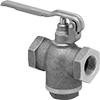Filter by
For Use With
Fitting Connection
Maximum Pressure @ Temperature
Valve Function
Maximum Temperature
DFARS Specialty Metals
Needle Material
Flow-Adjustment Valves
Flow-Adjustment Valves
Precision Flow-Adjustment Valves
Actuated Flow-Adjustment Valves
Precision Flow-Adjustment Valves for Chemicals
Balancing Valves
Precision Flow-Adjustment Valves for Steam
Laboratory Flow-Adjustment Valves
Metering Valves for Abrasive Blasting
Other Products



























































